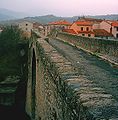- Céret
-
Céret
Devil's bridge Administration Country France Region Languedoc-Roussillon Department Pyrénées-Orientales Arrondissement Céret Canton Céret Mayor Alain Torrent
(2001–2008)Statistics Elevation 107–1,440 m (351–4,720 ft)
(avg. 154 m/505 ft)Land area1 37.86 km2 (14.62 sq mi) Population2 7,785 (2006) - Density 206 /km2 (530 /sq mi) INSEE/Postal code 66049/ 66400 1 French Land Register data, which excludes lakes, ponds, glaciers > 1 km² (0.386 sq mi or 247 acres) and river estuaries. 2 Population without double counting: residents of multiple communes (e.g., students and military personnel) only counted once. Coordinates: 42°29′21″N 2°45′08″E / 42.4891666667°N 2.75222222222°E
Céret (Catalan: Ceret) is a commune in the Pyrénées-Orientales department in southern France. It is the capital of Vallespir historical Catalan comarca.
Contents
Geography
The town lies in the foothills of the Pyrénées mountains, in southern France. It has an altitude of 175–1400 meters. It is located 7 km (4.3 mi) from the Autoroute A9, 200 km (120 mi) from Montpellier, 250 km (160 mi) from Toulouse and 180 km (110 mi) from Barcelona. It lies on the river Tech. The GR 10 footpath runs close by.
Main sites
Céret is famous for its Musée d'Art Moderne (Museum of Modern Art), which has numerous Picasso paintings, sculptures and ceramics, including the famous bull fighting bowl series. The museum also features paintings by Chagall, Matisse, Herbin, Soutine, lots of Fauves and a few Impressionists. The top floor of the Museum hosts touring exhibitions. The museum is open 364 days of the year.
The Pont du Diable (Devil's Bridge) is a single arch stone bridge built between 1321 and 1341. With a single span of 45.45 m, it was at the time of its construction the world's largest arch bridge in terms of span length.
Culture
Cherries
The region around Céret is major fruit producer, in particular famed for its cherries. The first of the season's pick are, by local tradition, sent to France's President. Céret hosts a cherry festival each year with such oddities as cherry beer and a cherry stone spitting competition. The cherry season is during the end of April and May. At this time, the town is at its most picturesque.
Bulls
Céret also holds an annual bull running festival known as la feria where young bulls (usually with their horns blunted) are run through the streets corralled by a group of highly skilled Camargue horsemen and women. Young bloods fired up on cheap local wine and wearing traditional red and yellow Catalan outfits, chase from behind in an attempt to catch hold of the bull's tail and hold on for as long as they can. Many bruises result although mostly it has to be said, to the ego. The feria is always held the weekend nearest to the 14th July, Bastille Day.
Dances
Céret regularly holds communal dances, where local amateurs or professionals dance in a ring. The dance is known as the sardanes. No pre-arrangement is made on the dancers behalf, locals note the time and place on posters around the city and turn up as they wish. More formal arrangements are also made on other occasions.
Market
Céret's Saturday market is a high point of the week and is as much a social event as anything else. It is a bustling, busy market selling mostly local produce. Fresh fruit and vegetable stalls are alongside the man who makes boudins blanc and noir. The olive stall is a "must see" where you can choose from a large range of plain, marinated and dried olives. The local cheese makers sell everything from the delicious fresh cheeses to aged hard cheese cut from large wheels. The local wines are red, cheap and very drinkable. The markets are much frequented by the large local English, Dutch, German and Scandinavian population that have moved to the Céret region in the last ten to fifteen years.
Artists
Céret has a continued tradition of being a home for artists, especially painters and poets. Pablo Picasso lived in Céret in the early part of the 20th century and Café Pablo in the town is dedicated to him. The Grand Café, still operating today, was a meeting place for many famous artists in the early part of the last century. Henri Matisse and Amadeo Modigliani, amongst other artists, visited at this time. Chaim Soutine, the Russian emigre painter, lived in Céret for a period and painted many landscapes of the village and its surrounds. Aristide Maillol, a famous sculptor born in the local village of Banyuls-sur-Mer, is represented by two public sculptures - one outside the visitors information centre and the other on the war memorial. Harold Weston, the American modernist, lived in a farmhouse above Céret from 1926 to 1929.
- Pablo Picasso (resident 1911 - 1912)
- Georges Braque (resident 1911 - 1912)
- Georges Badin (1986 - )
- Aristide Maillol
- Chaim Soutine
- Harold Weston (resident 1926-1929)
See also
References
External links
- City Council website / Ceret tourist information office
- Information in Catalan Encyclopaedia
- Museum of Modern Art website
Categories:- Communes of Pyrénées-Orientales
- Subprefectures in France
Wikimedia Foundation. 2010.







